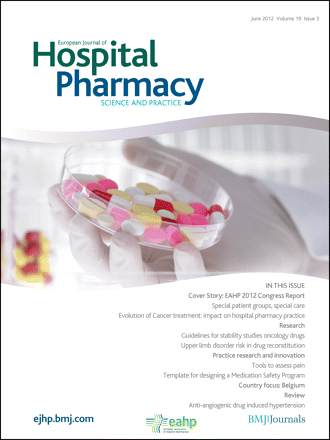EAHP EU Monitor 31 August 2012
The EAHP EU Monitor is a weekly round up of news relevant to hospital pharmacy in Europe.
You can subscribe to receive the EAHP EU Monitor by email here.
|
|
EAHP and EFPIA to work together on the future of medicines bar coding to the single unitThe European Association of Hospital Pharmacists (EAHP) and European Federation of Pharmaceutical and Industry Associations (EFPIA) have recently agreed to work towards a joint vision on the future of medicines bar coding to the single unit administered in hospitals. This is a long held policy goal of hospital pharmacists because of the strong evidence base for its role in reducing medication errors at the point of administration to the patient. The technology enables healthcare professionals to electronically verify that both the correct medication and the correct dose are being given to the correct patient at the bedside.
The two organisations have been exchanging information in relation to:
EFPIA recognise the potential for patient safety improvement that could be made by using medicines bar coding in this way, and have expressed their willingness to cooperate with hospital pharmacists in exploring ways to achieve systematic single unit bar coding. EAHP President Dr Roberto Frontini said:
“I am pleased that the European Federation of Pharmaceutical and Industry Associations are listening openly to EAHP’s request for systematic bar coding of medicines to the single dose administered in hospitals and are working with us to find the right solutions. Richard Bergström, EFPIA Director General said: "The implementation of the Falsified Medicines Directive is a real challenge and EFPIA wants to work with all stakeholders to set up a cost-effective product verification system to the benefit of all EU patients More information here. |
 |
Views of Hospital Pharmacists sought on syringe recappingEAHP has been asked to contribute the opinion of hospital pharmacists on a European regulation on syringe recapping and therefore seeks the responses of hospitals pharmacists to a short questionnaire. The issue is on the agenda for the social dialogue meeting between European health service employers and trade unions in September. Council Directive 2010/32/EU on prevention from sharp injuries in the hospital and healthcare sector, whilst commendable on insisting the need for risk assessment and approved safe-handling procedures to prevent injuries in hospitals, included under Clause 6 of its Annex the statement “the practice of recapping [syringes] shall be banned with immediate effect.” The provisional view of the EAHP is that such a ban, if implemented in full, is not proportionate to the risk presented in all circumstances. Instead, decisions in relation to recapping syringes should be left to professional discretion on the basis of risk assessment. However EAHP would like to test if this view is consistent with the views of its members. EAHP would therefore be grateful if hospital pharmacists could 5 minutes to complete the below short 5 question survey.
Hospital pharmacists are also welcome to share this questionnaire with their colleagues: http://www.surveymonkey.com/s/NY8MKD9 |
 |
EAHP accepted as eligible organisation to input to European Medicines Agency activity and working partiesEAHP has recently received notification that it has been successfully assessed as one of 12 European healthcare professional organisations eligible to give formal input to the work of the European Medicines Agency (EMA). EAHP is committed to engagement with EMA in order to ensure the perspectives of hospital pharmacists on such issues as EAHP will next represent hospital pharmacists at EMA’s joint meeting with patient and consumer organisations and healthcare professional organisations on Monday 25th and Tuesday 26th September. More information here. |
|
|
EJHP: A strategy for clinical pharmacy developmentAn article was published on the EJHP website this week on the development of clinical pharmacy in a large Teaching Hospital in Southampton, England. |






